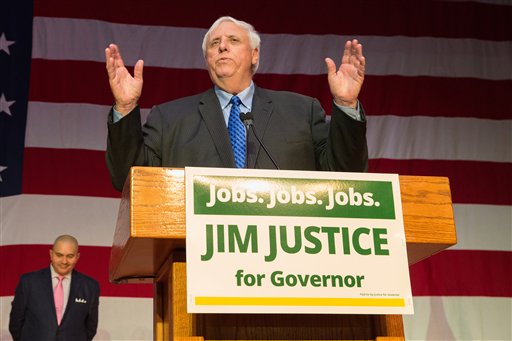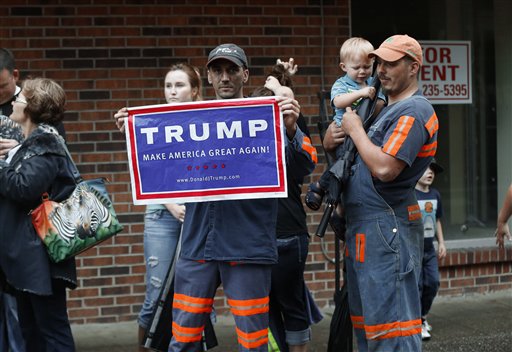Jim Justice is all in with Trump’s coal con
November 21, 2016 by Ken Ward Jr.
West Virginia Governor-elect Jim Justice speaks to supporters at the Greenbrier Resort in White Sulphur Springs, W. Va., after winning the 2016 West Virginia governors race on Tuesday, Nov. 8, 2016. (AP Photo/Walter Scriptunas II)
If you missed it in today’s Gazette-Mail, you should click here and check out the brief story about Gov.-elect Jim Justice’s phone call over the weekend with President-elect Donald Trump:
West Virginia governor-elect Jim Justice and President-elect Donald Trump discussed their plans for the future of the coal industry in a 15-minute phone call Saturday. Justice and Trump’s conversation focused on creating coal jobs, tourism, and other job possibilities, according to a press release from Justice.
Here’s the full press release that was issued on Saturday:
Today, President-elect Donald J. Trump called Governor-elect Jim Justice to congratulate him on his victory, and to discuss how to revive West Virginia’s coal industry. The fifteen-minute phone conversation focused primarily on how the two could work together to put coal miners back to work.
The Governor-elect took the call during his Greenbrier East basketball practice. During the conversation, Justice also discussed West Virginia’s tourism and other job possibilities with the President-elect.
“It’s an exciting day for West Virginia because we now have a pathway to the White House and a president-elect who is totally committed to putting our coal miners back to work,” said Governor-elect Jim Justice. “President-elect Trump made it clear that he won’t forget about West Virginia when it comes to our nation’s energy policies. I will work closely with the President-elect and his administration on clean coal technology, rolling back the job-killing EPA regulations on coal, and growing West Virginia’s other job opportunities.”
President-elect Trump asked Justice to pass along a message to the people of West Virginia: “We are going to get those coal miners back to work.”
Justice added, “President-elect Trump and I will work great together to bring new opportunities to West Virginia families. He also shared with me how much he cares about the people of West Virginia. Just as President-elect Donald J. Trump reached out to me, I am reaching out to Democrats and Republicans in the legislature to put aside party politics and pull the rope together to turn this state around.”
Let’s look at this part again:
The fifteen-minute phone conversation focused primarily on how the two could work together to put coal miners back to work … “It’s an exciting day for West Virginia because we now have a pathway to the White House and a president-elect who is totally committed to putting our coal miners back to work.”
We’ve written before in the Gazette-Mail (see here and here) and in this space (see here, here, here and here) about the aftermath of the presidential election and its implications for the West Virginia coal industry.

Coal miner Chris Steele holds a sign supporting Donald Trump outside a Democratic presidential candidate Hillary Clinton event in Williamson, W.V., Monday, May 2, 2016. (AP Photo/Paul Sancya)
There was an interesting piece in the Washington Post late last week that offered some examples of what the Trump administration might be able to do to help the coal industry:
Environmentalists are terrified of a Trump presidency. So are climate campaigners. But some observers say Trump’s peculiar campaign promises — and in particular, his pledge to help rescue the ailing coal industry — could, ironically, help to deliver one of the key missing pieces that researchers say is needed to fix climate change.
That piece is called “carbon capture and storage,” or for short, CCS. It actually refers to a nascent bevy of technologies that would allow for the stripping of carbon dioxide from various industrial processes, ranging from steel manufacturing to coal burning, and then sequestering it beneath the ground. In many cases, the pure streams of carbon dioxide can actually be used to help push more oil out of the earth in a procedure called “enhanced oil recovery,” potentially improving the economic value of the entire process.
There are a lot of reasons to be cautious about this story, to think it’s overly optimistic — not the least of which is that to spend money and political effort on CCS, President-elect Trump would have to decide that climate change isn’t a hoax by the Chinese to hurt American manufacturing industries. Gov.-elect Justice hasn’t gone quite that far from the facts on climate change, but he’s certainly not shown any real understanding of the issue or indicated he plans to do anything at all serious about it once he takes office.
And, while there are some things that could be done to help with CCS, as the story points out, the more effective routes aren’t necessarily going to get anywhere in the GOP in control of Congress and the White House:
… There are more sweeping policy changes that the United States could install that would further advantage CCS — but that might not be as politically palatable.
Taxing emissions of carbon, or regulating them through a policy like the Obama administration’s Clean Power Plan, would further help CCS to compete in the marketplace. Basically, it would make the competition tougher for its energy sector rivals that emit more CO2. However, politically, these seem far less likely to garner Republican support (Trump has pledged to reverse the Clean Power Plan).
Remember, too, that once upon a time, there was a bill that even the United Mine Workers of America said would save coal — but it couldn’t get through the U.S. Senate and the UMWA wouldn’t even formally endorse it.
That brings us back to what is the far more likely scenario for West Virginia’s coal industry, as explained in the latest version of the story, from The New York Times:
Donald J. Trump made coal a centerpiece of his campaign, holding rousing rallies with miners in hard hats, who he said had been neglected under eight years of the Obama administration. The strategy paid off, helping him score crucial wins in Pennsylvania and Ohio.
Now, though, coal may prove a different sort of symbol — that is, of the challenges that the president-elect will face delivering on his many promises to restore struggling sectors of the American economy.
The United States coal industry and the jobs that support it have been in decline for decades as a result of environmental concerns, automation in mining and slowdowns in manufacturing industries that burned coal for power.
And these days, no matter who is president, coal is at the mercy of market economics. Coal’s No. 1 rival is cheap, cleaner-burning natural gas — which could become an even more potent competitor under the incoming administration. The probable easing of restrictions on pipeline building and loosening of rules on gas exploration and production would mean more natural gas reaching the market.
“I don’t think the Trump presidency will have a material impact on bringing coal miners back to work,” said Ted O’Brien, a coal analyst at Doyle Trading Consultants, a leading energy industry research firm.
“He may eliminate the regulatory overhang,” Mr. O’Brien said, referring to the environmental rules that have cast a shadow over coal, “but I have a hard time seeing a surge in coal demand.”
President-elect Trump’s absurd promises to the coalfields even made this week’s episode of Saturday Night Live (go to roughly the two-minute mark):
All facts and expert analysis and even comedy aside, our West Virginia Gov.-elect, Jim Justice, is all in with continuing to give false hope to the state’s coal-mining families. Really, it’s not that funny.

 Subscribe to the Coal Tattoo
Subscribe to the Coal Tattoo
